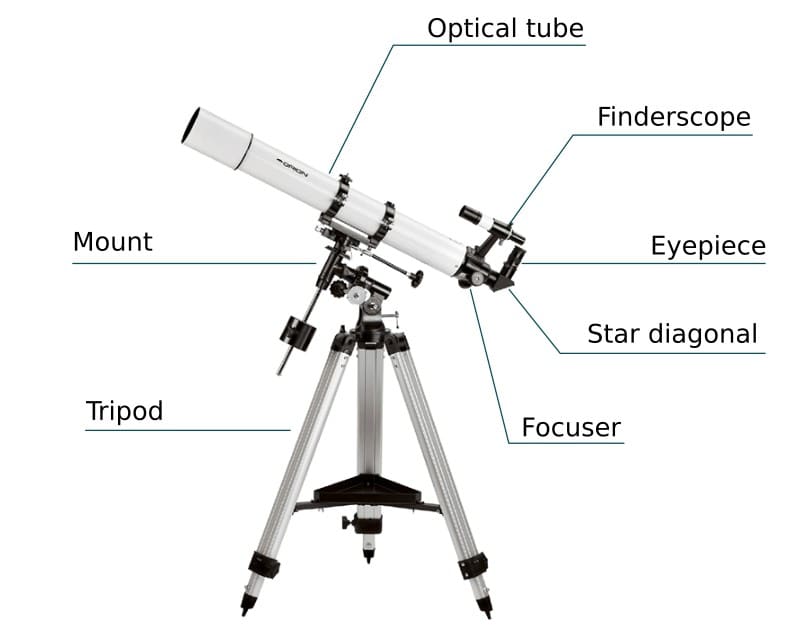Amateur stargazers mostly utilize two conventional forms of telescopes for their observations. These include refractors, which use lenses (or objective glasses, as they are often referred to) to construct the image, and reflectors, which employ a mirror for this purpose. Occasionally, catadioptric systems, which are a combination of multiple lenses and mirrors, are utilized to construct the image. The primary component of any telescope that constructs the image is the lens. Its characteristics, such as aperture D and focal length/focal ratio f/D, determine the range of observations that a particular telescope can achieve. Naturally, telescopes with a broad aperture (with a large lens diameter) are preferred due to their extensive collecting (light) surface, high resolving power, and significant magnification capabilities. However, telescopes with large apertures, regardless of their type, tend to be more costly and cumbersome.
Gathering surface and resolving power of telescopes
The aperture (D) is the most crucial feature of telescopes and binoculars. It represents the diameter of the objective lens, which determines the size of the collecting surface. The area of the collecting surface is directly proportional to the square of the diameter. Having a larger collecting surface enables the observation of fainter objects. Therefore, the limiting stellar magnitude that can be observed in a particular telescope is determined by the square of the lens diameter.
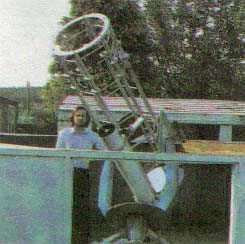
Figure 31: Reflector telescopes often utilize an open tube design, as seen in this 400-millimeter (16-inch) Newtonian reflector telescope.
One of the most important features of a telescope is its ability to resolve, or distinguish, the smallest details in the disks of planets or double stars. Resolving power is measured in arc seconds and is determined by the lens diameter. For lenses with a diameter measured in millimeters, the resolving power can be calculated using the formula 138/D. However, for long focal length lenses with focal ratios greater than f/12[1], the resolving power is slightly higher and can be calculated using the formula 116/D. Reflectors and catadioptric telescopes generally have slightly lower resolving power compared to refractor telescopes with the same lens diameter due to the shielding of the central part of the light beam that passes through the lens. Additionally, air currents inside the telescope tube can significantly impact the image quality, particularly for reflector telescopes.
Reflecting Telescopes
Reflector telescopes, commonly used by amateur astronomers, typically have focal ratios ranging from f/6 to f/8. These telescopes offer several advantages over refractor telescopes, including a wider field of view and lower magnification. There are different types of reflector telescopes, with the Newtonian and Cassegrain systems being the most popular among amateur observers. The Newtonian system features a flat secondary mirror, resulting in a constant focal length and focal ratio. On the other hand, the Cassegrain system uses a convex secondary mirror, which significantly increases the overall focal length of the telescope and alters its effective focal ratio. As a result, Cassegrain reflectors are often used for the same types of observations as refractor telescopes.
Nevertheless, reflectors possess certain drawbacks, with the most notable one being the requirement to periodically replace the reflective coatings and adjust the optical components. Without the use of costly optical glass to hermetically seal the reflector’s tube, it becomes essential to protect each mirror of the telescope with a covering or cap to prevent dust infiltration. Additionally, when observing through the eyepiece of a Newtonian telescope, one may find themselves in an uncomfortable position; to address this, it should be feasible to rotate the telescope tube.
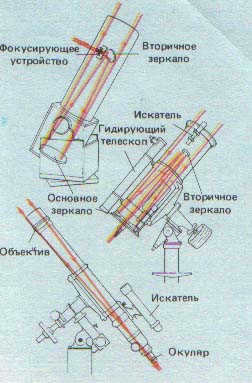

Figure 32. The Newton reflector telescope is mounted on a Dobsonian mount, allowing the telescope base to rotate around a central rod that is anchored to a sturdy foundation (top image). In the case of a Cassegrain reflector with a shorter telescope tube, the secondary mirror increases the effective focal length (middle image). Although standard refractor telescopes typically have focal ratios of f/10 and f/12, they are known for being easy to handle, compact, and portable (bottom image).
If the reflector tube is not completely sealed with an optical window, the intrusion of cold outside air can create air currents that degrade the quality of the image. One effective way to combat this issue is by using large heat-insulating tubes. However, more commonly, skeletal construction “tubes” are employed for this purpose. Unfortunately, this approach presents other challenges, such as warm air flows from the observer, which can be mitigated by wearing insulating clothing during observation. Additionally, this design choice can lead to increased dew deposition on the optical elements. Therefore, it is crucial to carefully consider the design of the observatory itself.
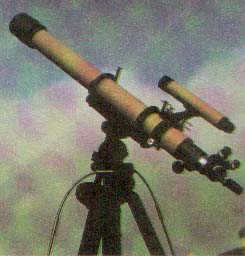
Figure 33. The most convenient type of telescope for various astronomical observations is a 75-millimeter (3-inch) achromatic refractor, like the one depicted here.
Telescope System with Catadioptric Design
Among catadioptric telescopes, the Maksutov and Schmidt-Cassegrain systems are the most popular. These telescopes are more portable and convenient for observations, especially when used in combination with various tracking devices that can track the complex motion of celestial bodies. Naturally, these telescopes are more expensive compared to refractors and reflectors of the same size. Catadioptric telescopes have large focal ratios: f/10, f/12, and even f/15, which allows them to perform the same tasks as Cassegrain system refractors and reflectors.
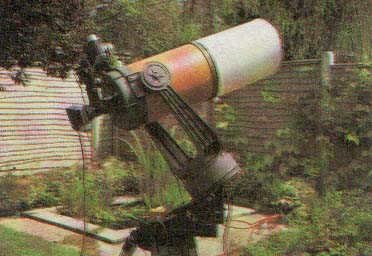
Figure 34. The convenience and portability of a catadioptric telescope make it suitable for various observations. The image shows a telescope equipped with a 200 mm (8 inch) lens.
Examination of Telescopes and Lenses
Several investigations into the quality of telescope optics can be conducted independently, although it is important to remember that no optical system is flawless. All optical systems distort images, which are known as aberrations. When constructing a telescope, it is crucial to minimize these aberrations. The specific requirements for acceptable aberration levels depend on the nature of the intended research. For instance, when studying planets, double stars, and capturing images of celestial objects, the tolerance for aberrations is higher compared to observing variable stars.
Chromatic aberration, which can be observed in binoculars, refractors, and certain other types of telescopes, is characterized by the appearance of color in the image of celestial bodies. This phenomenon is particularly noticeable at sharp transitions between light and dark areas, such as the edges of the Moon or Venus. However, reflector telescopes do not exhibit this type of aberration.
To determine the presence of distortion in the image, one can examine a straight line or rectangular brickwork on the wall of a house.
Examine how your telescope forms an image of a point source. It is ideal to do this test at night by observing the image of stars. You can also conduct these tests during the day by observing “artificial stars” (sunlight reflected by a distant balloon) or any other source of light that appears as a point. In a high-quality telescope, the star’s image should be perfectly focused and have the shape of a round diffraction disk. These images should maintain a circular shape both in focus and out of focus. If the image appears elongated, it indicates the presence of astigmatism or distortion in the telescope’s optical elements, which may be caused by improper mounting. Field curvature is indicated by the star’s image becoming blurred as it moves from the center to the edge of the telescope’s field of view. Most telescopes have some degree of field curvature, but this primarily affects photographic observations. Another aberration, known as coma, is characterized by the elongation of the star’s image (resembling a comet) at the edge of the field of view. Coma is also present in most telescopes, but it is more noticeable in reflectors than in refractors.

Figure 35. In order to study star-rich regions of the sky, such as the vicinity of ? and ? Centauri, it is necessary to use high magnification and long exposures. This puts greater strain on the optical properties of astronomical instruments.
Illustration 36. Severe distortions in the shape of celestial body images can occur at the periphery of a telescope’s field of view due to optical aberrations; the extent of these distortions can be observed in this aerial photograph.
Guidelines for utilizing the telescope
Once you have brought the telescope outside and are ready to begin observing, it is important to wait until the telescope’s temperature matches that of the surrounding air before starting. This typically takes around 15-20 minutes, and during this period, the image quality will be quite poor. Reflectors, with their substantial mirrors, take longer to reach thermal equilibrium with the surrounding air. However, if their optical systems are sufficiently flawless, achieving excellent image quality is easily accomplished through simple focusing, as experience has shown. While achieving this in visual observations is not overly challenging, it is necessary to wait for the temperatures to equalize when engaging in photography with long exposures.
A straightforward contraption known as the anti-sprinkler, crafted from an insulating substance of choice, offers a convenient solution for streamlining telescope setup. The incorporation of anti-sprinklers proves indispensable for reflectors, catadioptric telescopes, and even select models of binoculars. These compact hollow cylinders are affixed to the front of the objective, resembling a lens mount, yet without impeding the telescope’s field of view.
To ensure high-quality observations, it is crucial to keep all optical surfaces of the telescope clean. In order to prevent dust from accumulating, it is recommended to cover the refractor lens and the open end of the reflector tube tightly. Reflectors, on the other hand, should have individual covers for each mirror. It is important not to put caps on the optical elements until any traces of dew have completely evaporated. Ideally, telescopes should be stored in a dedicated box, although this is usually only necessary for refractors and catadioptric telescopes. Eyepieces should be removable and stored together with other small accessories in dust- and shock-proof cases. Despite being often overlooked, the focusing device of the telescope should also be safeguarded from dust and insects, particularly spiders, which tend to settle in this part of the telescope. It is crucial not to touch the optical surfaces of the telescope with bare fingers.
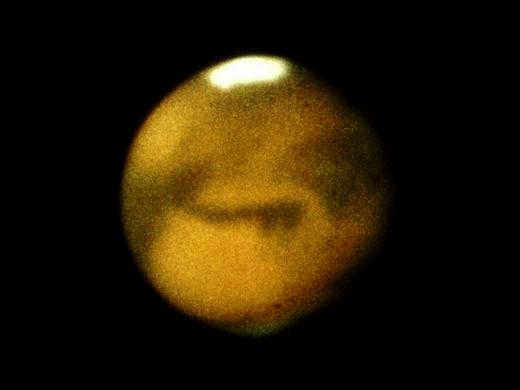
Figure 37. An image of Mars captured using a small amateur catadioptric telescope demonstrates the potential results that can be achieved with careful handling of the instrument and meticulous observation.
If you adhere to all of the aforementioned suggestions, there will be no necessity to regularly remove dirt from the optical surfaces. Typically, this task is performed no more than once per year. It is crucial to recognize that any scratches on the optical surfaces can cause significant damage; even visible dust deposits and subtle stains are less harmful to the optical quality compared to scratches. Cleaning the optical surfaces should only be considered as a last resort – when the contamination is severe enough to impact the image quality. Keep in mind that frequent cleaning of telescope optics does more harm than good!
Special care is required for the optical components of a telescope, particularly the reflective mirror coatings and lens coatings, as they are highly susceptible to damage. It is not recommended to wipe dust off the optical surface with a cloth; instead, it is preferable to use a specialized device to blow it off or gently brush it away with a soft brush designed for photography. If lenses with durable coatings are heavily soiled, it is advisable to first remove any dust from their surfaces and then clean them with a liquid specifically formulated for cleaning optical surfaces, using a soft cloth. It is worth noting that storing eyepiece lenses in special boxes can help prevent them from becoming dirty. In cases of more severe contamination or deterioration of reflective coatings, it is recommended to have them professionally cleaned (excluding dust removal) and have the reflective coating replaced at specialized workshops.
Various Kinds of Telescope Mounts
There are different options available for mounting telescopes, each with its own advantages and disadvantages. One of the simplest and most affordable options is the azimuthal mount. This type of mount allows the telescope to rotate around both the vertical and horizontal axes, enabling it to point in any direction in terms of azimuth and altitude. While the azimuthal mount is easy to use and suitable for various observations, it does have a drawback. The orientation of the field of view changes as the telescope is pointed at different parts of the sky, which can make it challenging to locate faint objects, especially when relying on star maps. However, with practice and experience, astronomers can still successfully make a wide variety of observations using an azimuthal mount, with the exception of photographic observations.
A different type of telescope mount is known as the equatorial mount. This mount has one axis that is parallel to the Earth’s axis (known as the polar axis) and another axis that is parallel to the celestial equator (known as the declination axis). By rotating around the polar axis at a speed that matches the daily rotation of the celestial sphere, the equatorial mount allows for automatic tracking of objects being observed, which is particularly useful for photography.
There is a type of equatorial mounting called the forked design, which is commonly used in industrial catadioptric telescopes. It is particularly useful for Newton system reflectors due to the placement of the eyepiece. Another commonly used mount is the German design, which is typically used for refractors and reflectors of the Cassegrain system. In this case, the eyepiece part is conveniently located. This type of mount is often utilized in Newton system reflectors that are produced for general sale.
In the Northern Hemisphere, a handheld telescope can easily be aligned with Polaris for various visual and photographic observations. To do this, aim the finder at Polaris and adjust the telescope’s position by declination and then by moving it back and forth in direct ascension. Make sure that the star stays within 1° of the center of the finder’s field of view by adjusting the telescope’s axes.
In the Southern Hemisphere, setting up the telescope is a more complex process as there is no bright star near the South Pole. However, there is a faint star called ? Octanta, which is about fifth magnitude and is within 1° of the pole.
When taking photos with long exposures, more precise methods of aligning the telescope are necessary. The quality of observations can be greatly improved by mounting the telescope on a stable and fixed support. This is important not only for large telescopes, but also for portable ones like the Schmidt, Kassegren, and Maksutov telescopes. The support can be made of metal or concrete and should be adjusted to the appropriate height for the specific telescope, considering different observing conditions. It is crucial that the support allows for adjustments in height and azimuth, as well as aligning the telescope with the Earth’s pole. Making these adjustments can sometimes be challenging. If the telescope needs to be removed and stored elsewhere, it can be secured to the top of the support using a special plate. This will save time in setting up and aligning the telescope for future observations.
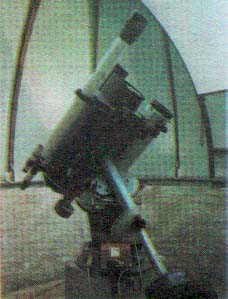
Figure 38 shows an equatorial mount that holds two cameras with apertures of 230 mm (9 in.) and 150 mm (6 in.) [focal ratios of f/4 and f/6.3, respectively], along with a guiding 75-mm (3 in.) refractor and a 150-mm reflector.
Methods of driving a telescope
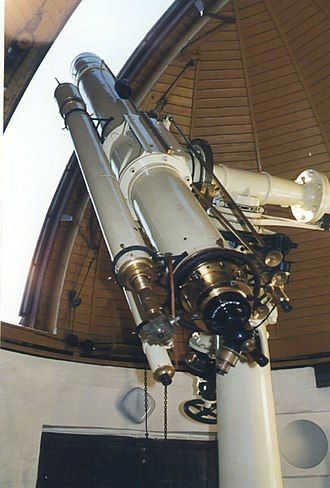
A refracting telescope (also known as a refractor) is an optical telescope that uses a lens as its objective to create an image (also known as a dioptric telescope). The original purpose of the refracting telescope design was for spyglasses and astronomical telescopes, but it is also used for long focus camera lenses. While refracting telescopes were highly popular in the latter half of the 19th century, they have mostly been replaced by reflecting telescopes for research purposes, as they allow for larger apertures. To calculate the magnification of a refractor, divide the focal length of the objective lens by the focal length of the eyepiece. [1]
Refractive telescopes typically feature a lens positioned at the front, followed by a lengthy tube, and finally an eyepiece or other instruments at the back where the image captured by the telescope is focused. Initially, telescopes utilized single-element lenses, but as time progressed, two- and even three-element lenses were developed.
A refractive telescope is a technology that is frequently employed in various other optical devices like binoculars and zoom lenses/telephoto lenses/long lenses.
Invention
The earliest type of optical telescope were refractors. The Netherlands saw the first appearance of a refracting telescope around 1608, when Hans Lippershey from Middelburg, who was the creator of spectacles, made an unsuccessful attempt to patent it. [2] The news of the patent spread rapidly and in May 1609, Galileo Galilei, who was in Venice at the time, heard about the invention and built his own version, which he used for his astronomical discoveries. [3]
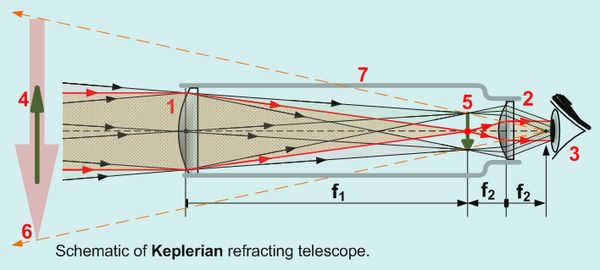
Refracting telescopes all utilize the same principles. They utilize a combination of an objective lens 1 and some sort of eyepiece 2 to collect more light than the human eye can gather, focus it 5, and present the viewer with a more intense, clearer, and enlarged virtual image. 6.
The lens of a refracting telescope refracts or bends light. This bending of light causes parallel light rays to come together at a focal point; while non-parallel rays come together at the focal plane. A telescope transforms a beam of parallel rays that form an angle α with the optical axis into a second parallel beam with an angle β. The ratio β / α is known as angular magnification. It is equivalent to the ratio of the size of the image on the retina of the eye obtained with and without the telescope. [4]
There are various arrangements of refractive telescopes that can correct image orientation and different types of aberrations. These telescopes are known as refracting telescopes or refractors, as the image is formed through the bending or refraction of light.
The Galileo Telescope
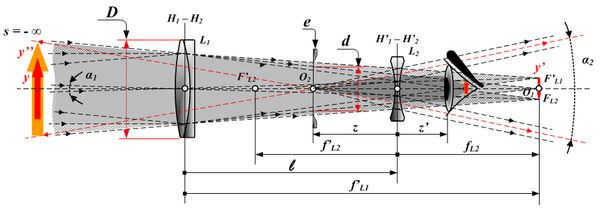
Optical diagram of the Galilean telescope у – A distant object; y ′ – The actual image produced by the lens; у ″ – Magnified virtual image produced by the eyepiece; D – Entrance pupil diameter; d – Virtual exit pupil diameter; L1 – Objective lens; L2 – Eyepiece lens; е – Virtual exit pupil – The telescope is equivalent to [5]
The Galilean telescope, known as Galileo’s telescope, was designed by Galileo Galilei around 1609. [6] It consisted of a flat-convex objective lens and a flat-concave eyepiece lens (Galileo, 1610). [7] Unlike other designs, the Galilean telescope does not have an intermediate focus, resulting in a non-inverted and, with the aid of additional devices, direct image. [8]
Galileo had a telescope that was incredibly powerful, measuring 980 millimeters (3 feet 3 inches) in total length,[6] which allowed him to magnify objects by about 30 times. [8] However, the telescope had some design flaws, including a lens shape and a narrow field of view,[8] resulting in blurry and distorted images. Despite these limitations, the telescope was still sufficient for Galileo to observe the sky. He used it to study craters on the Moon,[9] the four largest moons of Jupiter,[10] and the different phases of Venus. [11]
The ultimate picture (у ″) is an imaginary picture situated at an infinite distance and is placed in an upward direction as the original object.
Kepler telescope
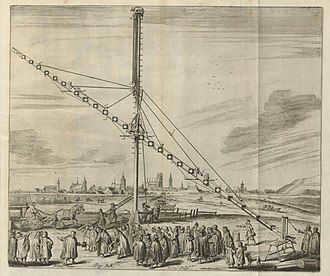
An engraved image shows a telescope designed by Johannes Hevelius, which is a Keplerian astronomical refractor telescope. It has a focal length of 46 m (150 ft). [12]
The Keplerian telescope, invented by Johannes Kepler in 1611, is an improvement on Galileo’s design. [13] Instead of Galileo’s concave lens, it uses a convex lens as an eyepiece. This arrangement has the advantage of converging the rays of light coming out of the eyepiece [dubious – discuss], resulting in a wider field of view and increased eye relief. However, the image seen through the telescope is inverted. This design allows for much higher magnification, but a simple lens must have a very high f-ratio to overcome aberrations (Johannes Hevelius built one with a 46-meter (150-foot) focal length, and even longer chamberless “airborne telescopes” have been constructed). Additionally, this design enables the use of a micrometer at the focal plane to determine the angular size and/or distance between observed objects.
Achromatic telescopes without color distortion
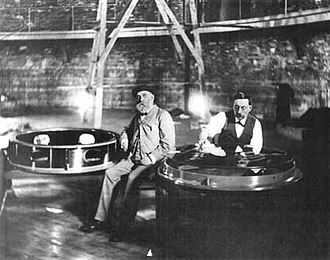
The achromatic lens, a revolutionary invention in the development of refracting telescopes, emerged as a major breakthrough. It effectively addressed the issue of chromatic aberration and enabled the use of shorter focal lengths. This groundbreaking lens was first invented in 1733 by Chester Moore Hall, an English lawyer. Interestingly, around 1758, John Dollond independently invented and patented the same lens design. By incorporating a lens composed of two distinct types of glass, namely “Crown” and “colorless glass,” the design effectively reduced both chromatic and spherical aberration, eliminating the need for excessively long focal lengths. The manufacturing process involves grinding and polishing each side of the two glass pieces before combining them. The achromatic lenses are meticulously corrected to converge two specific wavelengths, typically red and blue, onto a single focal plane.
In 1730, Chester More Hall became famous for inventing the first lens with dual color correction. [15]
The Dollond achromats gained significant popularity during the 18th century. [16] [17] Their main advantage was their ability to be made shorter. [17] However, the size of glass lenses was limited to four inches in diameter due to difficulties in glass production. [17]
In the late 19th century, glass manufacturer Guinand invented a method for producing larger glass blanks, exceeding four inches in size. [17] He also shared this innovation with his apprentice Fraunhofer, who further refined the technique and also designed Fraunhofer’s duplex lenses. [17] This advancement in glass technology paved the way for the development of impressive refractors during the 19th century, which gradually grew in size and eventually surpassed one meter by the century’s end. However, these refractors were later replaced in astronomy by telescopes made of silvered glass.
Renowned manufacturers of lenses during the 19th century include: [18]
At the Royal Observatory, Greenwich, there was a telescope called the Sheepshanks Telescope in 1838, which had the Koshua objective. [24] The Sheepshanks Telescope, with a lens measuring 6.7 inches (17 cm) wide, remained the largest telescope at Greenwich for approximately twenty years. [25]
In a report from the Observatory in 1840, it was mentioned that Sheepshanks had acquired a new telescope with a Koshua doublet: [26]
The power and quality of this telescope make it a valuable addition to the observatory’s collection of instruments.
During the 1900s, Zeiss emerged as a prominent manufacturer of optics. [27] The Zeiss 12-inch refractor at Griffith Observatory, which has been in operation since 1935, is a remarkable example of refractors’ capabilities. Over 7 million people have had the opportunity to observe through this telescope, representing the largest number of people to have looked through a telescope. [27]
Achromats gained popularity in the field of astronomy due to their use in star catalogs and their low maintenance requirements compared to metal mirrors. Notable astronomical discoveries made using achromats include the identification of the planet Neptune and the moons of Mars.
Despite having a smaller aperture than larger reflectors, long achromats were frequently utilized in prestigious observatories. Throughout the late 18th century, observatories would regularly unveil larger and longer refractors every few years.
For instance, the Nice Observatory introduced a 77-centimeter refractor (30.31 inches), which was the largest at the time. However, this record was quickly surpassed within just a couple of years. [28]
Apochromatic refractors
An apochromatic lens typically consists of three elements that redirect light of three distinct frequencies to a shared focal point.
Apochromatic refractors are crafted using unique materials with extremely low dispersion. They are engineered to focus three wavelengths (typically red, green, and blue) onto the same plane. The remaining color error (tertiary spectrum) can be significantly smaller than that of an achromatic lens. [ citation needed ] These telescopes incorporate fluorite elements or specialized ultra-low dispersion (ED) glass in the objective lens, resulting in an exceptionally sharp image with minimal chromatic aberration. [29] Due to the specific materials required for production, apochromatic refractors are typically more expensive than other telescopes of similar aperture size.
In the 18th century, Dollond, a well-known producer of doublet telescopes, also ventured into making triplets, although they did not gain the same level of popularity as their doublet counterparts. [17]
One of the most renowned triplet objectives is the Cook triplet, which gained recognition for its exceptional ability to correct Zeidahl aberrations. [30] It is widely regarded as one of the most significant objective designs in the field of photography. [31][32] The Cook triplet is capable of correcting spherical aberration, coma, astigmatism, field curvature, and distortion using just three lens elements for a single wavelength. [32]
Technical factors to consider
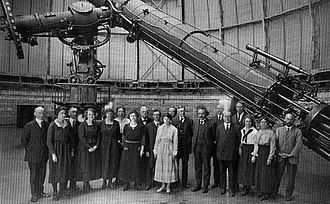
The Yerkes Observatory is home to the largest achromatic refractor ever used in astronomy, measuring 102 cm (40 in) in length (photo taken on May 6, 1921, during Einstein’s visit).
Refractors are prone to residual chromatic and spherical aberration, with shorter focal ratios being more affected than longer ones. A 100mm (4 inch) refractor with a focal ratio of 6 is likely to exhibit noticeable color fringing, often seen as a purple halo around bright objects. However, a 100mm (4 inch) refractor with a focal ratio of 16 will have minimal color fringing.
Another challenge faced by refractors is lens sagging, which occurs in very large apertures due to gravity deforming the glass. Since the lens can only be supported at the edges, the center of the large lens sags under the influence of gravity, resulting in distorted images. The largest practical lens size for a refracting telescope is approximately 1 meter (39 inches). [33]
One more issue that arises is the presence of defects in the glass, such as stretching or small imperfections, as well as air bubbles that get trapped inside. Additionally, certain wavelengths are unable to pass through the glass due to its opacity, and even visible light is hindered by reflection and absorption when it encounters air-glass interfaces and travels through the glass itself. Fortunately, reflecting telescopes have come to the rescue by allowing for the construction of much larger apertures and have largely replaced refractors in the field of astronomical research, thereby avoiding or minimizing these aforementioned problems.
An instance showcasing the utilization of refractors in space is the ISS-VAC on Voyager 1/2, which employed a lens with a diameter of 6 cm (2.36 in) and was launched into space during the late 1970s. [34]
Implementations and accomplishments
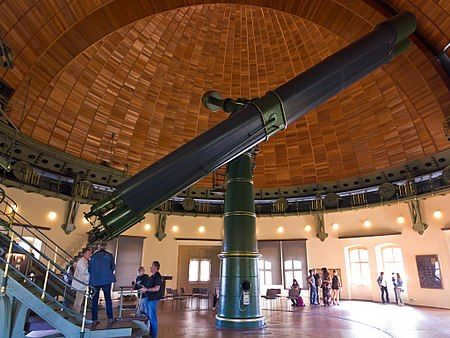
The “Große Refraktor”, a dual telescope equipped with lenses measuring 80 cm (31.5 in) and 50 cm (19.5 in), was employed in 1904 to identify calcium as a component of the interstellar medium.
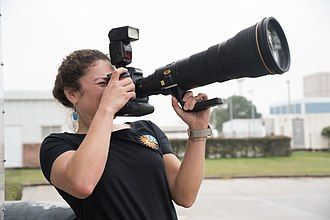
Refractive telescopes have been widely used in astronomy and for observing Earth. Singlet refractors played a crucial role in the early discoveries of our solar system.
The use of refractive telescope optics is prevalent in photography and also in Earth’s orbit.
Galileo’s use of the refractive telescope in 1609 led to the discovery of Jupiter’s four largest satellites, making it one of the most notable applications of this technology. Additionally, the first refractors were later utilized to discover Titan, Saturn’s largest satellite, along with three other satellites of Saturn.
During the 19th century, refracting telescopes played a crucial role in the fields of astrophotography and spectroscopy. These instruments were instrumental in groundbreaking research and were even used to determine the distance to distant stars. Despite their relatively small aperture, these telescopes still managed to make significant discoveries. However, their limited capabilities meant that many celestial objects remained inaccessible until the development of long exposure photography. As a result, the reputation and advantages of reflecting telescopes eventually surpassed those of refracting telescopes. Nevertheless, refractors still made notable contributions, such as the discovery of Mars’ moons, Jupiter’s fifth moon, and numerous double stars, including the famous Sirius. In addition to their astronomical applications, refractors were also commonly used for positional astronomy, as well as photography and Earth observation.
Single-element lenses and airborne telescopes were used to discover Galileo’s satellites and other satellites in the solar system.
In 1610, Galileo Galilei used a refracting telescope to discover the Galilean satellites of Jupiter. [35]
Dutch astronomer Christiaan Huygens discovered Titan, the moon of the planet Saturn, on March 25, 1655. [36] [37]
Doublets In 1861, Dearborn’s 18-inch refractor telescope was utilized to uncover that Sirius, the brightest star in the night sky, had a smaller stellar companion.
By the 18th century, refractors faced competition from reflectors, which were larger and didn’t have the same issue with chromatic aberration. However, the astronomical community still preferred using small aperture refractors over modern instruments. Notable discoveries made with these refractors include the moons of Mars and Jupiter’s fifth moon, Amalthea.
On August 12, 1877, Asaph Hall discovered Deimos at around 07:48 Universal Global Time. Phobos was discovered on August 18, 1877, by the U.S. Naval Observatory in Washington, D.C., at about 09:14 GMT. (According to the pre-1925 astronomical convention that the day began at noon, modern sources give the opening times of August 11 2:40 p.m. and August 17 4:06 p.m. Washington Mean Time respectively.)
The discovery of Jupiter’s satellite Amalthea took place on September 9, 1892, when Edward Emerson Barnard used a 36-inch (91 cm) refractor telescope at Lick Observatory. [44][45] Amalthea was found through direct visual observation using a refractor with a double-lens. [35]
In 1904, the Potsdam Great Refractor, a double-lens double telescope, was used to make a discovery about the interstellar medium. [46] Astronomer Prof. Hartmann determined that the element calcium was present in the intermediate space based on observations of the double star Mintaka in Orion. [46]
The planet Pluto was discovered by examining photographs taken with a blinking comparator using a refracting telescope, specifically an astrograph with a 3-element 13-inch lens, which were colloquially referred to as “saucers” in the language of astronomy. [47] [48]
List of prominent refracting telescopes
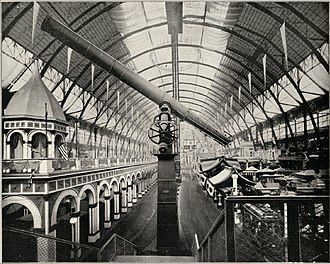
The Yerkes Great refractor, which was exhibited at the 1893 World’s Fair in Chicago, was the tallest, longest, and had the largest aperture among refractors of that era.


Here are some examples of the largest achromatic refracting telescopes with a diameter of over 60 cm (24 in).
- The Large Telescope at the 1900 Paris Exposition was dismantled after the Exposition. It had a diameter of 1.25 meters or 49 inches.
- The Yerkes Observatory has a diameter of 101.6 cm or 40 inches.
- Sweden’s first solar telescope has a diameter of 98 cm or 39 inches.
- The Lick Observatory has a diameter of 91 cm or 36 inches.
- The Paris Observatory Medon Great Refractor has a diameter of 83 cm (33 inches), with an additional 62 cm (24 inches).
- The Potsdam Great Refractor has a diameter of 80 cm (31 inches), with an additional 50 cm (20 inches).
- The Nice Observatory has a diameter of 77 cm or 30 inches.
- The John Wall dialite refractor, the largest refractor built by man at the Hanwell Community Observatory, has a diameter of 76.20 cm or 30 inches.
- The Great Refractor at the Vienna Observatory has a diameter of 69 centimeters or 27 inches.
- The Archenhold Observatory is home to the longest refractor telescope ever built, with a focal length of 68 cm or 27 inches and a length of 21 m or 69 feet.
- The U.S. Naval Observatory has a refractor telescope with a diameter of 66 centimeters or 26 inches.
- The National Observatory of Athens houses the Newall Refractor, which has a diameter of 62.5 centimeters or 24.6 inches.
- The Lowell Observatory has a refractor telescope with a diameter of 61 centimeters or 24 inches.
Related Links
Additional Resources
Suggestions
- ^ “Telescope Calculations. North Stars. Retrieved December 20, 2013.”
- ^ Albert van Helden, Sven Dupre, Rob van Gent, The origins of the telescope, Amsterdam University Press, 2010, pages 3-4, 15
- ^ Science, Lauren Cox 2017-12-21T03:30:00Z; Astronomy. “Who invented the telescope?”. Space.com. Retrieved October 26, 2019.
- ^ Stephen G. Lipson, Ariel Lipson, Henry Lipson, Optical Physics 4th edition, Cambridge University Press,
- ISBN 978-0-521-49345-1
- ^http://upload.wikimedia.org/wikipedia/commons/1/17/Galileantelescope_2.png
- ab"Galileo’s Telescope – An Instrument." Museo Galileo: Institute and Museum of the History of Science. 2008 . Retrieved September 27, 2020 .
- ^ Sidereus Nuncius or Starry Messenger, 1610, Galileo Galilei et al., 1989, pp. 37, The University of Chicago Press, Albert van Helden tr. (Rice University Department of History, Houston, Texas),
- ISBN 0-226-27903-0.
- abc"Galileo’s Telescope – How It Works." Museo Galileo: Institute and Museum of the History of Science. 2008 . Retrieved September 27, 2020 .
- ^ Edgerton, S. Y. (2009). Mirror, window, and telescope: how Renaissance linear perspective changed our view of the universe. Ithaca: Cornell University Press. p. cm. 159. ISBN9780801474804 .
- ^ Drake, S. (1978). Galileo at work. Chicago: University of Chicago Press. pp. 153. ISBN978-0-226-16226-3 .
- ^"Phases of Venus." Intellectual math. June 2, 2019. Retrieved September 27, 2020.
- ^ Hevelius, Johannes (1673). Machina Coelestis. First part. Auctor.
- ^ Tunnacliffe, AH; Hurst, J. G. (1996). Optics. Kent, England. pp. 233-7. ISBN978-0-900099-15-1.
- ^Paul Schlyter, The world’s largest optical telescopes
- ^ Tromp, R. M. (December 2015). “Adjustable electron achromat for cathode-ray lens microscopy”. Ultramicroscopy. 159, Pet. 3: 497-502. doi:10.1016 / j.ultramic.2015.03.001. ISSN1879-2723. PMID25825026.
- ^"The Dollond Telescope. National Museum of American History . Retrieved November 19, 2019 .
- ^ abcdef English, Neil (September 28, 2010). Choosing and using a refractor telescope. Springer Science & Business Media. ISBN9781441964038 .
- ^ Lankford, John (March 7, 2013). History of astronomy: an encyclopedia. Routledge. ISBN9781136508349 .
- ^[1]
- ^"Cauchois, Robert-Aglaye". Canvases, Carats, and Rarities. March 31, 2015 . Retrieved October 26, 2019 .
- ^ Ferguson, Kitty (March 20, 2014). "The glassblower who started astrophysics". Nautilus . Retrieved October 26, 2019 .
- ^ Lequier, James (March 15, 2013). Leverrier: An Astronomer Who Inspires Awe and Disgust. Springer Science & Business Media. ISBN978-1-4614-5565-3 .
- ^"1949PA . 57 . 74K pp. 75". article.adsabs.harvard.edu . Retrieved November 19, 2019 .
- ^"The canine telescope". UK: Royal Museums Greenwich . Retrieved February 27, 2014 .
- ^ Tombaugh, Clyde W .; Moore, Patrick (September 15, 2017). Emerging from the Shadows: Exploring the Planet Pluto. Stackpole Books. ISBN9780811766647 .
- ^Astronomical observations made at the Royal Observatory, Greenwich, . Clarendon Press. 1840 г.
- ^ аб[2]
- ^Observatory, "Large Telescopes," p. 248
- ^“Starizona’s guide to CCD imaging”. Starizona.com. Retrieved October 17, 2013.
- ^ Kidger, Michael J. (2002). Fundamental optical design. SPIE Press. ISBN9780819439154.
- ^ Vasiljevic, Darko (December 6, 2012). Classical and evolutionary algorithms for optimization of optical systems. Springer Science & Business Media. ISBN9781461510512.
- ^ ab Vasiljevic, Darko (2002), “Cook triplet optimization”, in Vasiljevic, Darko (eds), Classical and evolutionary algorithms for optimization of optical systems, Springer, USA, pp. 187-211, doi:10.1007/978-1-4615-1051-2_13, ISBN9781461510512
- ^ Stan Gibilisco (2002). Demystifying physics. McGraw-Hill. p.532. ISBN978-0-07-138201-4.
- “Voyager.” Astronautix.com.
- ab Bakich, M. E. (2000). Cambridge planetary guide. Cambridge University Press. Pp. 220-221.
- ISBN 9780521632805.
- “Lifting the veil of titanium” (PDF). Cambridge. P. 4. Archived from the original (PDF) on February 22, 2005.
- “Titan.” Astronomical picture of the day. NASA. Archived from the original on March 27, 2005.
- Campbell, W.W. (1918). “The beginning of the astronomical day”. Publications of the Pacific Astronomical Society. 30 (178): 358. Bibcode:1918PASP. 30..358C. doi:10.1086/122784.
- Notes: satellites of Mars. Observatory, Vol. 1, no. 6. September 20, 1877. Pp. 181-185. Retrieved September 12, 2006.
- ^ Hall, A. (October 17, 1877). “Observations on the satellites of Mars” (Signed September 21, 1877). Astronomische Nachrichten, Vol. 91, No. 2161. P. 11 / 12-13 / 14. . Retrieved September 12, 2006 .
- ^ Morley, T. A ; Catalog of ground-based astrometric observations of the satellites of Mars, 1877-1982., Astronomy and Astrophysics Supplement Series, Vol. 77, No. 2 (February 1989), pp. 209-226 (Table II, p. 220: first observation of Phobos 1877-08-18.38498)
- ^“Telescope: 26-inch refractor of the Naval Observatory”. amazing-space.stsci.edu . Retrieved October 29, 2018 .
- ^“26-inch great equatorial ‘refractor'”. U.S. Naval Observatory . Retrieved October 29, 2018 .
- ^ Barnard, E. E. (October 12, 1892). "Discovery and observations of the fifth satellite of Jupiter". The Astronomical Journal. 12 (11): 81-85. Bibcode:1892AJ.12.81B. doi:10.1086/101715.
- ^ Lick Observatory (1894). A brief report of the Lick Observatory of the University of California. University Press. p. 7-.
- ^ аб Canipe, Jeff (January 27, 2011). Cosmic communication: how astronomical events affect life on Earth. Prometheus Books. ISBN9781591028826 .
- ^"Pluto Telescope. Lowell Observatory. Retrieved November 19, 2019.
- ^"Pluto Discovery Plate". National Air and Space Museum. Retrieved November 19, 2019.
- ^[3]
External link
The content of this page originates from Wikipedia. The text is accessible under the CC BY-SA 3.0 Unported License. Non-text media is available under its designated licenses. Wikipedia® is a registered trademark of the Wikimedia Foundation, Inc. Wikijaa.ru is an autonomous company and is not associated with the Wikimedia Foundation.

A refractor telescope (also known as a refractor) is a type of optical telescope that utilizes a lens as its objective for the formation of images (also referred to as a dioptric telescope). The initial application of the refractor telescope design was in spyglasses and astronomical telescopes, but it is also used in long-focus camera lenses. While large refracting telescopes were widely popular in the second half of the 19th century, they have mostly been replaced by reflecting telescopes for most research purposes, as larger apertures can be used with the latter. The magnification of a refractor is determined by dividing the focal length of the objective lens by the focal length of the eyepiece. [1]
Refractive telescopes typically feature a front lens, followed by a lengthy tube, and finally an eyepiece or instruments at the rear, which is where the telescope image is brought into focus. In the beginning, telescopes were equipped with single-element lenses, but as time passed, two- and even three-element lenses were developed.
A refractive telescope is a technology that is commonly employed in various other optical devices, including binoculars and zoom lenses/telephoto lens/long lens.
Invention
The invention of refractors, the earliest type of optical telescope, can be traced back to the Netherlands in 1608. Hans Lippershey, a spectacles creator from Middelburg, attempted to patent the refracting telescope but was unsuccessful. However, news of the patent quickly spread, and in May 1609, Galileo Galilei, who was in Venice at the time, learned about the invention. He constructed his own version of the refracting telescope and used it to make significant astronomical discoveries.

Refracting telescopes all operate on the same principles. They utilize an objective lens 1 and an eyepiece 2 to gather more light than the naked eye can capture, focus it 5, and present the observer with a virtual image that is brighter, clearer, and magnified 6.
The objective lens of a refracting telescope refracts or bends light. This bending of light causes parallel rays to converge at a central focal point, while non-parallel rays converge at the focal plane. The telescope transforms a beam of parallel rays that form an angle α with the optical axis into a second parallel beam with an angle β. The ratio of β to α is known as angular magnification. It is the ratio of the size of the image on the eye’s retina obtained with and without the telescope. [4]
There are various configurations of refractive telescopes available to correct image orientation and different types of aberrations. These telescopes, which use light bending or refraction to form images, are commonly referred to as refracting telescopes or refractors.
The Galileo Telescope

Optical diagram of the Galilean telescope у – A distant object; y ′ – The real image produced by the lens; у ″ – Magnified virtual image produced by the eyepiece; D – Entrance pupil diameter; d – Virtual exit pupil diameter; L1 – Objective lens; L2 – Eyepiece lens е – Virtual exit pupil – The telescope is equal to [5]
The design utilized by Galileo Galilei circa 1609 is commonly known as Galileo’s telescope. [6] It consisted of a gathering (flat-convex) objective lens and a diverging (flat-concave) eyepiece lens (Galileo, 1610). [7] The Galileo telescope, due to its lack of an intermediate focus, provides a non-inverted and, with the help of certain devices, direct image. [8]
Galileo had a telescope that was 980 millimeters long (3 feet 3 inches),[6] and it could magnify objects about 30 times. [8] However, this telescope had some design flaws, such as a lens shape and a narrow field of view,[8] which caused the images to be blurry and distorted. Nevertheless, Galileo was able to use this telescope to observe the sky. He looked at the craters on the Moon,[9] the four largest moons of Jupiter,[10] and the different phases of Venus. [11]
When light rays from a distant object (у) travel in parallel, they are focused at the focal plane of the objective lens (F ′ L1 / y ′). The diverging eyepiece lens (L2) then intercepts these rays and makes them parallel again. However, when non-parallel rays of light from an object that is at an angle of α1 to the optical axis pass through the eyepiece, they emerge at a larger angle (α2> α1). This causes an increase in the apparent angular size of the object and is what creates the perceived magnification.
The resulting image (у ″) is a virtual image that is located at infinity and appears to be positioned above the object.

An engraved image depicts a Keplerian astronomical refractor telescope created by Johannes Hevelius, which has a focal length of 46 m (150 ft). [12]
The Keplerian telescope, which was invented by Johannes Kepler in 1611, is an improvement on Galileo’s design. Instead of using a concave lens, Kepler’s telescope uses a convex lens as an eyepiece. This arrangement has the advantage of converging the rays of light coming out of the eyepiece, allowing for a wider field of view and increased eye relief. However, the image is inverted for the viewer. This design also allows for higher magnification, but to overcome aberrations, the simple lens must have a very high f-ratio. For example, Johannes Hevelius built a Keplerian telescope with a 46-meter (150-foot) focal length. There have even been longer chamberless “airborne telescopes” constructed. The design of the Keplerian telescope also enables the use of a micrometer at the focal plane to determine the angular size and/or distance between observed objects.
Huygens constructed a flying telescope for the Royal Society in London, equipped with a single-element lens measuring 19 cm (7.5 inches) in diameter. [14]
Achromatic refractors

The achromatic lens, a multiple element lens that solved issues with chromatic aberration and allowed for shorter focal lengths, was a significant advancement in the development of refracting telescopes. In 1733, an English lawyer named Chester Moore Hall invented this lens, although it was also independently invented and patented by John Dollond around 1758. This design addressed the need for long focal lengths in refracting telescopes by utilizing a lens composed of two pieces of glass with different characteristics, specifically “Crown” and “colorless glass”, to minimize chromatic and spherical aberration. Both sides of each piece are carefully ground and polished before being combined. The achromatic lenses are precisely corrected to focus two wavelengths, typically red and blue, in the same plane.
Dollond achromats gained popularity during the 18th century [16] [17] because they had the advantage of being shorter in length. [17] However, the production of glass lenses was limited to a diameter of four inches due to difficulties in glassmaking. [17]
In the late 19th century, Guinand, a glass manufacturer, discovered a method for producing larger and higher quality glass blanks exceeding four inches in diameter. [17] This knowledge was then passed on to Fraunhofer, Guinand’s apprentice, who further refined the technology and developed the design of Fraunhofer’s duplex lenses. [17] The advancement in glass technology resulted in the creation of powerful refractors during the 19th century, with sizes progressively increasing over the years, eventually reaching over 1 meter by the end of the century. However, these telescopes were later replaced by silvered glass telescopes in the field of astronomy.
Notable manufacturers of lenses during the 19th century were: [18]
There were several renowned refractors in the 19th century, such as the James Leake Telescope, which had a diameter of 91 cm (36 inches), and the Greenwich Refractor, which measured 28 inches (71 cm). The Schackburg Telescope, which dates back to the late 1700s, is an example of an older refractor. Another famous refractor was the Trophy Telescope, which made its debut at the 1851 Great Exhibition in London. The 19th century was a golden age for refractors, with remarkable achromatic lenses being developed. The pinnacle of this era was the Great Telescope, the largest achromatic refractor ever constructed, showcased at the Paris Exhibition of 1900.
The Royal Observatory in Greenwich housed the Sheepshanks Telescope, an instrument from 1838 that featured a Koshua objective. This telescope had a lens that was 6.7 inches (17 cm) in diameter, making it the largest telescope at Greenwich for approximately two decades.
In a report from 1840, the Observatory mentioned the then-new Sheepshanks Telescope, equipped with a Koshua doublet.
The addition of this telescope to the observatory instruments is highly welcomed due to its exceptional power and quality.
Zeiss, a prominent optics manufacturer in the 1900s, holds a remarkable record with its 12-inch refractor at Griffith Observatory. Since its opening in 1935, over 7 million people have had the opportunity to gaze through this telescope, setting a record for the largest number of individuals to observe through a single telescope.
Achromats gained popularity in astronomy for their use in star catalogs and their low maintenance requirements compared to metal mirrors. Notable discoveries made using achromats include the identification of the planet Neptune and the moons of Mars.
Despite having a smaller aperture than larger reflectors, long achromats were frequently utilized in prestigious observatories. Throughout the late 18th century, observatories would regularly acquire larger and longer refractors every few years.
Take, for instance, the Nice Observatory, which first introduced a refractor measuring 77 centimeters (30.31 inches) in diameter. At the time, it was the largest of its kind, but it didn’t hold that title for long. Just a few years later, another telescope surpassed it in size. [28]
Apochromatic refractors
An apochromatic lens typically comprises of three elements, each of which redirects light of three distinct frequencies to a central focal point.
Apochromatic refractors use lenses made from specialized materials with extremely low dispersion. These lenses are designed to bring three wavelengths (typically red, green, and blue) into focus at the same point. The residual color error, or tertiary spectrum, is significantly smaller compared to achromatic lenses. [ citation needed ] These telescopes often incorporate fluorite elements or special ultra-low dispersion (ED) glass in the objective lens, resulting in exceptionally sharp images with minimal chromatic aberration. [29] Due to the unique materials required for their construction, apochromatic refractors tend to be more expensive than other telescopes of similar aperture.
In the 18th century, Dollond, a well-known producer of doublet telescopes, also manufactured triplets, although they weren’t as popular as doublets. [17]
One of the most well-known objectives in the world of photography is the Cook triplet. It has gained popularity due to its exceptional capability to correct Zeidahl aberrations. [30] The Cook triplet design is widely regarded as one of the most significant advancements in objective design. [31][32] This remarkable design employs only three lens elements to correct various optical aberrations, including spherical aberration, coma, astigmatism, field curvature, and distortion, all at a single wavelength. [32]
Technical Considerations
When it comes to technical aspects, there are several considerations to take into account.

On May 6, 1921, while Einstein was visiting, a photo was taken of the largest achromatic refractor ever used in astronomy, the 102 cm (40 in) refractor at Yerkes Observatory.
Refractors are affected by residual chromatic and spherical aberration, with shorter focal ratios being more affected than longer ones. A 100mm (4 inch) refractor with a focal ratio of 6 is likely to exhibit significant color fringing, often seen as a purple halo around bright objects. However, a 100mm (4 inch) refractor with a focal ratio of 16 will have very little color fringing.
Another problem that arises with very large apertures is lens sagging, which is a result of gravity deforming the glass. Since the lens can only be supported at the edge, the center of the large lens sags due to gravity, causing distortion in the resulting images. The largest practical lens size in a refracting telescope is approximately 1 meter (39 inches) [33].
Another issue that arises with glass is the presence of defects, such as stretching or small imperfections, as well as the presence of air bubbles that become trapped within the glass. Additionally, glass has the tendency to be opaque to certain wavelengths, meaning that even visible light is hindered by reflection and absorption as it passes through air-glass interfaces and the glass itself. However, these challenges can largely be overcome or minimized through the use of reflecting telescopes, which are capable of being constructed with much larger apertures. In fact, reflecting telescopes have become the preferred choice over refractors for astronomical research.
An interesting example of the use of refractors in space is the ISS-VAC on Voyager 1 /2, which utilized a 6 cm (2.36 in) diameter lens that was launched into space during the late 1970s. [34]
Uses and Accomplishments

The “Große Refraktor” was a dual telescope equipped with lenses measuring 80 cm (31.5 in) and 50 cm (19.5 in). It was utilized in 1904 to identify calcium as a component of the interstellar medium.

Refracting telescopes have long been renowned for their applications in astronomy and Earth observation. Singlet refractors played a vital role in the early discoveries of our solar system.
The versatility of refracting telescope optics extends to fields like photography and Earth orbit.
One of the most notable achievements associated with the refracting telescope is Galileo’s use of it in 1609 to unveil Jupiter’s four largest satellites. Additionally, the first refractors were instrumental in the discovery of Titan, Saturn’s largest satellite, along with three other satellites orbiting Saturn.
During the 19th century, refracting telescopes played a crucial role in the fields of astrophotography and spectroscopy. These instruments were instrumental in making groundbreaking discoveries, such as calculating the distance to distant stars using the heliometer. Despite their small aperture, refracting telescopes still managed to make significant contributions to astronomy. However, their limitations became apparent when it came to observing certain astronomical objects, until the introduction of long exposure photography. As a result, reflecting telescopes gradually gained more popularity and surpassed refractors in terms of reputation and capabilities. Nonetheless, refractors were responsible for important discoveries, including the identification of the moons of Mars and Jupiter, as well as numerous double stars like Sirius. Apart from astronomy, refractors were also utilized for positional astronomy, photography, and Earth observation.
The satellites of Galileo and other satellites in the solar system were found using single-element lenses and airborne telescopes.
In 1610, Galileo Galilei used a refracting telescope to discover the Galilean satellites of Jupiter.
Dutch astronomer Christiaan Huygens discovered Titan, the moon of Saturn, on March 25, 1655.
DoubletsIn 1861, Dearborn’s 18-inch refractor telescope revealed that Sirius, the brightest star in the night sky, had a smaller stellar companion.
By the 18th century, refractors faced competition from reflectors, which were larger and did not have the same issue with chromatic aberration. However, the astronomical community continued to use smaller refractors compared to modern instruments. Noteworthy discoveries made with these refractors include the moons of Mars and Jupiter’s fifth moon, Amalthea.
On August 12, 1877, Asaph Hall discovered Deimos at approximately 07:48 Universal Global Time, and on August 18, 1877, he discovered Phobos at around 09:14 GMT. The discoveries were made at the U.S. Naval Observatory in Washington, D.C. (according to modern sources using the pre-1925 astronomical convention that the day began at noon, the opening times were August 11 at 2:40 p.m. and August 17 at 4:06 p.m. Washington Mean Time, respectively).
The discovery of Jupiter’s moon Amalthea took place on September 9, 1892, when Edward Emerson Barnard used a 36-inch (91 cm) refractor telescope at Lick Observatory. [44][45] Through direct visual observation with a double-lens refractor, it was identified. [35]
In 1904, the Potsdam Great Refractor (a double-lens double telescope) made a significant discovery regarding the interstellar medium. [46] Prof. Hartmann, an astronomer, determined that the element calcium was present in the intermediate space based on observations of the double star Mintaka in Orion. [46]
During the examination of photographs (referred to as “saucers” in the language of astronomy) taken with a refracting telescope, specifically an astrograph with a 3-element 13-inch lens, the planet Pluto was discovered. [47] [48]
Compilation of significant refracting telescopes

The Yerkes Great refractor was installed at the 1893 World’s Fair in Chicago. It was the tallest, longest, and had the largest aperture of any refractor up to that time.

Here are some examples of achromatic refracting telescopes with a diameter of over 60 cm (24 in).
- The Large Telescope at the 1900 Paris Exposition had a diameter of 1.25 meters (49 inches) and was dismantled after the Exposition.
- The Yerkes Observatory has a diameter of 101.6 cm (40 inches).
- Sweden’s first solar telescope has a diameter of 98 cm (39 inches).
- The Lick Observatory has a diameter of 91 cm (36 inches).
- The Paris ObservatoryMedon Great Refractor has a diameter of 83 cm (33 inches) and an additional 62 cm (24 inches).
- The Potsdam Great Refractor has a diameter of 80 cm (31 inches) and an additional 50 cm (20 inches).
- The Nice Observatory has a diameter of 77 cm (30 inches).
- The John Wall dialite refractor, the largest refractor built by man at the Hanwell Community Observatory, has a diameter of 76.20 cm (30 inches) [49].
- The Vienna Observatory has a great refractor telescope, which measures 69 centimeters or 27 inches in diameter.
- The Archenhold Observatory is known for having the longest refractor telescope ever built, with a focal length of 68 cm or 27 inches and a length of 21 m or 69 feet.
- The U.S. Naval Observatory has a refractor telescope that measures 66 centimeters or 26 inches in diameter.
- The National Observatory of Athens is home to the Newall Refractor, which has a diameter of 62.5 centimeters or 24.6 inches.
- The Lowell Observatory has a refractor telescope with a diameter of 61 centimeters or 24 inches.
Related Articles
Further Resources
Recommended Reading
- ^“Calculations for Telescopes. North Stars.” Retrieved on December 20, 2013.
- ^ Albert van Helden, Sven Dupre, Rob van Gent, The origins of the telescope, Amsterdam University Press, 2010, pages 3-4, 15
- ^ Science, Lauren Cox 2017-12-21T03:30:00Z; Astronomy. “Who discovered the telescope?”. Space.com. Retrieved on October 26, 2019.
- ^ Stephen G. Lipson, Ariel Lipson, Henry Lipson, Optical Physics 4th edition, Cambridge University Press,
- ISBN 978-0-521-49345-1
- ^http://upload.wikimedia.org/wikipedia/commons/1/17/Galileantelescope_2.png
- ab"Galileo’s Telescope – An Instrument." Museo Galileo: Institute and Museum of the History of Science. 2008 . Retrieved September 27, 2020 .
- ^ Sidereus Nuncius or Starry Messenger, 1610, Galileo Galilei et al., 1989, pp. 37, The University of Chicago Press, Albert van Helden tr. (Rice University Department of History, Houston, Texas),
- ISBN 0-226-27903-0.
- ^ abc"Galileo’s Telescope – How It Works." Museo Galileo: Institute and Museum of the History of Science. 2008 . Retrieved September 27, 2020 .
- ^ Edgerton, S. Y. (2009). Mirror, window and telescope: how Renaissance linear perspective changed our view of the universe. Ithaca: Cornell University Press. p. cm. 159. ISBN9780801474804 .
- ^ Drake, S. (1978). Galileo at work. Chicago: University of Chicago Press. pp. 153. ISBN978-0-226-16226-3 .
- ^"Phases of Venus." Intellectual math. 2 Jun 2019 . Retrieved September 27, 2020 .
- ^ Hevelius, Johannes (1673). Machina Coelestis. First part. Auctor.
- ^ Tunnacliffe, AH; Hurst, J. G. (1996). Optics. Kent, England. С. 233-7. ISBN978-0-900099-15-1 .
- ^Paul Schlyter, The world's largest optical telescopes
- ^ Tromp, R. M. (December 2015). "Adjustable electron achromat for cathode-ray lens microscopy". Ultramicroscopy. 159, Pet. 3: 497-502. doi:10.1016 / j.ultramic.2015.03.001. ISSN1879-2723. PMID25825026.
- ^“The Dollond Telescope. National Museum of American History. Retrieved November 19, 2019.
- ^ abcdef English, Neil (September 28, 2010). Choosing and using a refractor telescope. Springer Science & Business Media. ISBN9781441964038.
- ^ Lankford, John (March 7, 2013). History of astronomy: an encyclopedia. Routledge. ISBN9781136508349.
- ^[1]
- ^“Cauchois, Robert-Aglaye”. Canvases, Carats, and Rarities. March 31, 2015. Retrieved October 26, 2019.
- ^ Ferguson, Kitty (March 20, 2014). “The glassblower who started astrophysics”. Nautilus. Retrieved October 26, 2019.
- ^ Lequier, James (March 15, 2013). Leverrier: An Admirable and Reprehensible Astronomer. Springer Science & Business Media. ISBN978-1-4614-5565-3 .
- ^"1949PA . 57 . 74K pp. 75". article.adsabs.harvard.edu . Retrieved November 19, 2019 .
- ^"The sheepdog telescope". UK: Royal Museums Greenwich . Retrieved February 27, 2014 .
- ^ Tombaugh, Clyde W .; Moore, Patrick (September 15, 2017). Out of the darkness: Pluto, the Planet. Stackpole Books. ISBN9780811766647 .
- ^Astronomical observations made at the Royal Observatory, Greenwich, . Clarendon Press. 1840.
- ^ аб[2]
- ^Observatory, "Large Telescopes," p. 248
- 1"Starizona’s guide to CCD imaging". Starizona.com . Retrieved October 17, 2013 .
- 2 Kidger, Michael J. (2002). Fundamental optical design. SPIE Press. ISBN9780819439154 .
- 3 Vasiljevic, Darko (December 6, 2012). Classical and evolutionary algorithms for optimization of optical systems. Springer Science & Business Media. ISBN9781461510512 .
- 4 ab Vasiljevic, Darko (2002), "Cook triplet optimization", in Vasiljevic, Darko (eds), Classical and evolutionary algorithms for optimization of optical systems, Springer, USA, pp. 187-211, doi:10.1007/978-1-4615-1051-2_13, ISBN9781461510512
- 5 Stan Gibilisco (2002). Demystifying physics . McGraw-Hill. п.532. ISBN978-0-07-138201-4 .
- ^"Voyager." Astronautix.com..
- ^ ab Bakich, M. E. (2000). Cambridge planetary guide. Cambridge University Press. Pp. 220-221.
- ISBN 9780521632805.
- ^"Lifting the veil of titanium" (PDF) . Cambridge. P. 4. Archived from the original (PDF) on February 22, 2005.
- ^"Titan. Astronomical picture of the day. NASA. Archived from the original on March 27, 2005.
- ^ Campbell, W.W. (1918). "The beginning of the astronomical day". Publications of the Pacific Astronomical Society. 30 (178): 358. Bibcode:1918PASP . 30..358C. doi:10.1086/122784 .
- ^"Notes: satellites of Mars". Observatory, Vol. 1, no. 6. September 20, 1877. Pp. 181-185. . Retrieved September 12, 2006 .
- ^ Hall, A. (October 17, 1877). "Observations on Mars’ moons" (Signed September 21, 1877). Astronomische Nachrichten, Vol. 91, No. 2161. pp. 11 / 12-13 / 14. . Retrieved September 12, 2006 .
- ^ Morley, T. A ; Catalog of astrometric observations of Mars’ moons from ground-based telescopes, 1877-1982., Astronomy and Astrophysics Supplement Series, Vol. 77, No. 2 (February 1989), pp. 209-226 (Table II, p. 220: first recorded sighting of Phobos on 1877-08-18.38498)
- ^"Telescope: 26-inch refractor at the Naval Observatory". amazing-space.stsci.edu . Retrieved October 29, 2018 .
- ^"26-inch refracting telescope". U.S. Naval Observatory . Retrieved October 29, 2018 .
- ^ On October 12, 1892, E. E. Barnard made a significant discovery and conducted observations of the fifth satellite of Jupiter. This was documented in the scientific journal The Astronomical Journal, volume 12, issue 11, pages 81-85. The publication can be found with the Bibcode: 1892AJ . 12 . 81B and doi:10.1086/101715.
- ^ In 1894, the Lick Observatory of the University of California released a brief report. This report can be accessed through the University Press, specifically on page 7.
- ^ аб In his book titled “Cosmic communication: how astronomical events affect life on Earth,” Jeff Canipe explores the impact of astronomical events on our planet. The book was published in January 27, 2011 by Prometheus Books and has an ISBN of 9781591028826.
- ^ The Pluto Telescope is housed at the Lowell Observatory. For more information, please visit their official website. (Retrieved: November 19, 2019)
- ^ The National Air and Space Museum features the Pluto Discovery Plate. To learn more about this artifact, visit their official website. (Retrieved: November 19, 2019)
- ^[3]
external link
The content of this page originates from Wikipedia. The information provided is licensed under the CC BY-SA 3.0 Unported License. Non-text media is subject to its specified licenses. Wikipedia® is a registered trademark of the Wikimedia Foundation, Inc. zahn-info-portal.de is an independent company and is not affiliated with the Wikimedia Foundation.
This is perhaps the most crucial question for individuals interested in purchasing a telescope. Let us attempt to objectively describe the pros and cons of refractors and reflectors (presently, there is a clear divide between supporters of refractors and reflectors).
What is the arrangement of telescopes with different optical schemes?
Telescopes with different optical schemes are organized in various ways. An optical telescope is specifically designed for observing distant celestial objects. When translated from Greek to Russian, the word “telescope” means “observing in the distance”.
For beginners in astronomy, it is important to understand how telescopes work and the different types of optical systems that exist. When visiting an optical store, novice astronomers often ask the salesperson, “What is the magnification of this telescope?” However, this question is actually incorrect and may come as a surprise to some.
Isn’t it all about gathering light?
There is a misconception that a telescope’s value is determined by its magnification. Some people believe that a higher magnification brings distant objects closer. However, both of these beliefs are incorrect. The primary purpose of a telescope is to collect electromagnetic radiation waves, including visible light. This term also encompasses other waves such as radio waves, infrared radiation, ultraviolet radiation, X-rays, and more. Modern telescopes are capable of detecting all of these regions.
Therefore, the most crucial aspect of a telescope is not its magnification power, but rather its ability to gather light. The more light that the lens or mirror can collect, the clearer the resulting image will be.
What do telescopes look like?
How do telescopes function? There are several fundamental types of telescopes:
- refractors. Refractors incorporate only lenses in their design. They operate by bending light rays;
- reflectors. Reflectors are composed entirely of mirrors, with the telescope’s design consisting of a main mirror and a secondary mirror;
- catadioptrics or hybrid telescopes. These telescopes utilize both lenses and mirrors.
Refractor vs Reflector: Which is the Superior Telescope?
Throughout history, there has been a prevailing belief that the “true” telescope is a refracting telescope, characterized by its familiar lens structure. However, the refracting lens is not necessarily superior to its reflecting counterpart, and in some aspects, it may even be better. So why does this belief persist? It could be due to the earlier occurrence of refraction in history, or perhaps because it resembles a telescope that was once widely renowned and popular. Additionally, manufacturers have predominantly produced refractors, which were often handmade and seen as somewhat rebellious within the telescope community.
However, times have changed, and now it is easy to purchase both refractors and reflectors of equal quality. This leads to an ambiguous question: which type of telescope is truly superior?
It should be noted that the choice of observation equipment greatly depends on individual needs and preferences. However, let us analyze the matter more seriously and discuss the situations where a refractor or a reflector would be more suitable.
Advantages of a refractor
A refractor is a lens-based system that offers several advantages and disadvantages. Some of the advantages include:
- A refractor has a closed tube design, with both the lens and eyepiece sealed. This ensures that no dust, moisture, or other contaminants enter the tube, resulting in minimal maintenance requirements. Furthermore, the absence of air currents in a closed tube prevents image distortion.
- The design of a refractor is sturdier, and the lens and eyepiece remain properly aligned over time. This makes it convenient to carry while traveling.
- The refractor lens is designed to be always ready for use. Simply take out the telescope, set it up, and you’re good to go – it only takes a few minutes.
- With the refractor lens, there is minimal maintenance required over time, apart from regular cleaning. The glass retains its properties, ensuring the same high-quality image even after several years of use.
- Unlike other telescopes, the refractor lens does not have any additional components that can introduce diffraction distortions or reduce image brightness. This ensures a clear and bright image every time.
- The refractor lens is incredibly user-friendly, making it an ideal choice for beginners. It is even designed with models specifically for curious children.
These are the primary advantages of refractors that are often cited by their supporters. However, it is important to note that there are also some disadvantages to consider.
Drawbacks of the refractor
There are certain disadvantages associated with the design of the refractor that may significantly impact your choice of telescope.
- One drawback of using a refractor is the occurrence of chromatic aberration, which results in a colored halo around observed objects. This phenomenon can be mitigated by employing complex multi-lens designs, which are typically more expensive.
- Even the slightest defects in the glass or inconsistencies in its structure can lead to a noticeable decrease in image quality.
- When light passes through the lens of a refractor, the violet and ultraviolet portions of the spectrum are absorbed by the glass, especially in thicker and larger lenses.
- In addition to the light passing through multiple lenses, a refractor also experiences light loss through reflection on their surfaces.
- Having a refractor telescope with a diameter of 80-90 mm is already quite impressive, and larger diameters require a fixed location.
- These are a few of the main drawbacks of refractor telescopes.
How does a refractor telescope function?
In a refracting telescope, a highly magnified image of a distant object is produced by the objective lens (3) (4). This image is then observed through the eyepiece (6), similar to looking through a magnifying glass. In some designs, the eyepiece is positioned perpendicular to the tube axis instead of on it (7), allowing the image from the objective lens to be transmitted to the eyepiece through a refracting lens (8).
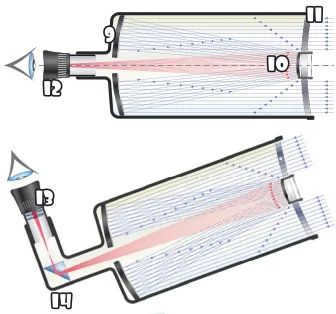
Paris Giant
A refractor telescope of unprecedented proportions was constructed specifically for the Paris World’s Fair in 1900. Boasting an objective lens with a staggering diameter of 1.25 m and a tube stretching over 60 m in length, this astronomical marvel captured the attention of fairgoers. Nevertheless, due to its immense physical dimensions and weight, the telescope was affixed in a fixed, horizontal position. Regrettably, this arrangement rendered the telescope impractical for further use, ultimately leading to its disassembly in 1909.
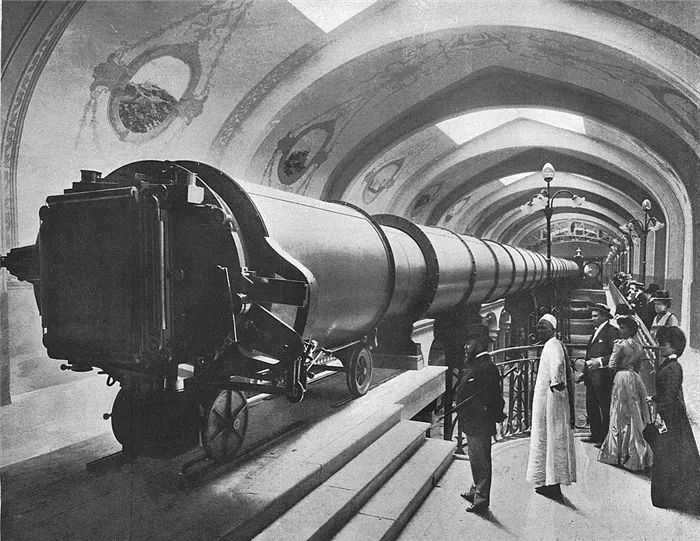

Recorder of Reflectors
Reflecting telescopes are considerably larger than refracting telescopes. The Roque de los Muchachos Observatory in the Canary Islands houses the world’s largest mirror – the Large Canary Telescope. Constructed in 2007, its mirror has a diameter of 10.4 meters, which is 10 times larger than the lens of the biggest refractive telescope!

Considerations regarding the technical aspects
Refractors encounter challenges related to residual chromatic and spherical aberration. These issues are more prominent in smaller focal length ratios compared to larger ones. A 100 mm (4 inches) achromatic lens with an f-number of 6 is likely to exhibit noticeable color fringing, often characterized by a purple halo around bright objects. On the other hand, a 100mm (4 inch) lens at f/16 only has minimal color fringing.
When dealing with very large apertures, it becomes necessary to address the problem of lens weakening caused by gravitational deformation of the glass. Due to the fact that the lens can only be held by its edge, the center of the large lens experiences deformation under the influence of gravity, leading to distorted images. In practical terms, the largest feasible lens size in a refracting telescope is approximately 1 meter (39 inches).
There is another issue with glass, which involves defects such as grooves or small air bubbles that get trapped inside the glass. Additionally, glass has the tendency to become opaque in certain wavelength ranges. Even visible light gets obscured due to reflection and absorption as it passes through air-glass interfaces and the glass itself. Fortunately, reflecting telescopes have largely resolved or minimized these problems. They can be constructed with much larger apertures and are now mostly replacing refractors for astronomical research.
An illustration of the usage of a refractive lens in outer space is the ISS WAC on the Voyager 1/2 spacecraft. It utilized a 6 cm (2.36″) diameter lens, which was launched into space during the late 1970s.
Applications and Achievements
Astronauts are trained to use large lens cameras.
Lens telescopes are widely used in astronomy and for observing Earth. Single-lens refractors have played a significant role in early discoveries of the solar system.
Refractive optics of telescopes are commonly used in photography and in space exploration.
One of the most notable applications of refracting telescopes was in the field of astronomy, specifically by Galileo, who in 1609 discovered the four largest moons of Jupiter. Additionally, several decades later, the first refractors were used to discover Titan, the largest satellite of Saturn, as well as three other satellites of Saturn.
Galileo Galilei and numerous other celestial bodies within the solar system were found utilizing single-element lenses and aerial telescopes.
In the year 1610, Galileo Galilei stumbled upon Jupiter’s satellites with the aid of a refracting telescope.
Christiaan Huygens, a Dutch astronomer, made the discovery of Titan, a satellite of the planet Saturn, on March 25, 1655.
Using an 18.5-inch Dearborn refractor telescope in 1861, it was revealed that Sirius, the brightest star in the night sky, possesses a smaller stellar companion, known as a doppelganger.
Reflecting telescopes, which were able to overcome the issue of chromatic aberration and could be much larger in size, posed a serious competition to lenticular telescopes by the 18th century. Despite this, the astronomical community still relied on double refractors with smaller apertures compared to modern instruments. Noteworthy discoveries made using these telescopes include the identification of the moons of Mars and Jupiter’s fifth moon, Amalthea.
In 1877, Asaph Hall made significant discoveries at the U.S. Naval Observatory in Washington, D.C. He spotted Deimos on August 12 at around 07:48 UTC and Phobos on August 18 at about 09:14 GMT. It is important to note that these times are based on the pre-1925 astronomical convention, which started at noon, with August 11 14:40 and August 17 16:06 Washington Mean Time being the corresponding start times.
A refracting telescope with a lens measuring 26 inches (66 cm) in diameter was utilized for the initial sighting, located at Foggy Bottom. In 1893, the lens was relocated and housed within a new dome, where it remains to this day in the 21st century.
Edward Emerson Barnard discovered Jupiter’s moon Amalthea on September 9, 1892, using a dual-lens refracting telescope measuring 36 inches (91 cm) in diameter at Lick Observatory. The discovery was made through direct visual observation.
One of the notable findings in 1904 using the Potsdam Large Refractor, a refracting telescope equipped with two double lenses, was the detection of the interstellar medium. While observing the double star Mintaka in Orion, Professor Hartmann identified the presence of calcium within the interstellar medium.
List of the largest refracting telescopes
University of Vienna Observatory is home to a 68 cm (27 in) refractor.
Here are some examples of the largest telescopes with achromatic lenses that have a diameter over 60 cm (24 inches).
- The large telescope of the 1900 Paris Exposition had a diameter of 1.25 m or 49 inches. Unfortunately, it was dismantled after the exhibition.
- Yerkes Observatory boasts a 101.6 cm or 40-inch refractor.
- Sweden’s first solar telescope had a diameter of 98 cm or 39 inches.
- Lick Observatory houses a 91 cm or 36-inch refractor.
- The Paris Observatory Methodon Great Refractor had a diameter of 83 cm (33 inches) and an additional 62 cm (24 inches).
- The Potsdam Great Refractor had a diameter of 80 cm (31 inches) and an additional 50 cm (20 inches).
- Nice Observatory features a 77 centimeter or 30-inch refractor.
- The largest refractor built by man is the John Wall dialite refractor telescope with a diameter of 76.20 cm or 30 inches, located at the Hanwell Community Observatory.
- The Royal Greenwich Observatory is home to Grubb’s 28-inch refractor, which features a lens with an aperture of 71 cm or 28 inches.
- The Vienna Observatory boasts the Great Refractor, equipped with a lens measuring 69 centimeters or 27 inches.
- At the Archenhold Observatory, you can find the longest refractor telescope ever built, with a focal length of 68 cm or 27 inches and a length of 21 m or 69 feet.
- The U.S. Naval Observatory houses a refractor telescope with a lens measuring 66 cm or 26 inches.
- The National Observatory of Athens is home to the Newall refractor, which features a lens with a diameter of 62.5 cm or 24.6 inches.
- Lowell Observatory is equipped with a refractor telescope measuring 61 cm or 24 inches.
Top-rated models
Let’s examine the features of the most sought-after refracting telescopes on the market.
Veber 360/50 AZ.
The Veber 360/50 AZ telescope is an ideal choice for beginners in astronomy. It offers a distortion-free image and is equipped with a convenient azimuth mount. This model is well-suited for observing the planets within our solar system, studying lunar craters, and getting acquainted with the landscapes of our planet. It allows for a deep view into space, although the level of detail in the image may be slightly reduced.
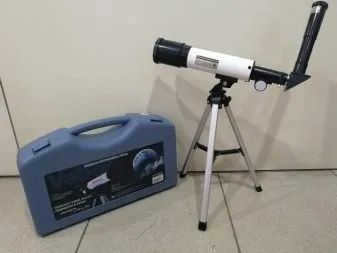

Levenhuk Skyline BASE 50T.
The Levenhuk Skyline BASE 50T is equipped with a magnification range of 18x to 90x, providing a wide range of viewing options. With its thin and lightweight design, this telescope is highly portable and easy to handle. It comes with a hard case that ensures safe transportation and convenient storage.
This model is not only suitable for children but also for budding astronomers who are looking for their first introduction to celestial bodies. The telescope is designed to be easy to assemble and maintain, making it a perfect choice for beginners. Its powerful optics enable users to observe various celestial objects, including planets, the moon, and even objects on the ground.
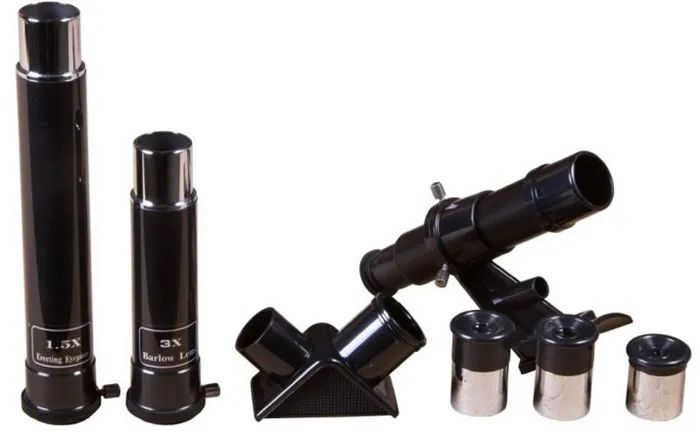
The glass lenses of this refractor telescope are completely illuminated, ensuring a clear and high-contrast image, even when viewing objects at high magnification. To observe celestial objects, a 5x optical viewfinder is used. However, it is important to note that this refractor telescope flips the image from top to bottom. To correct this, an optional accessory, a diagonal electric mirror, can be added to eliminate any image distortion.
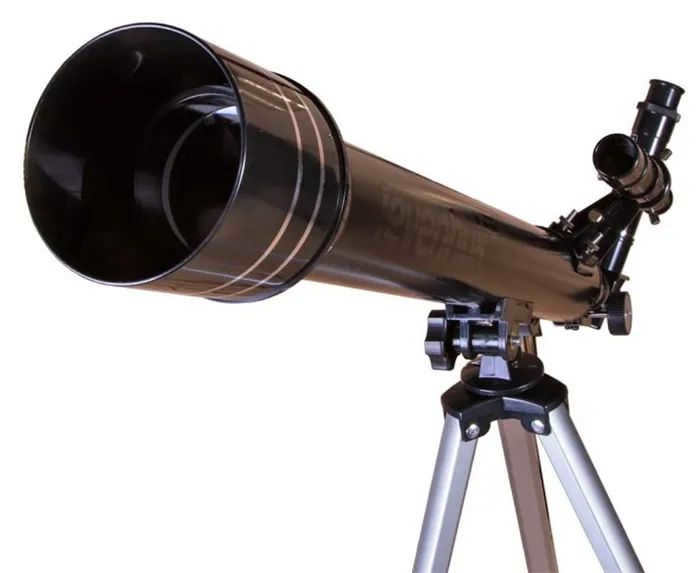
The refractor telescope can be aligned to the object being studied quickly and easily using the azimuthal mount. The telescope is mounted on a sturdy metal tripod with adjustable legs, allowing observers of all heights to customize the height of the telescope. Additionally, the tripod features an accessory box where a compass, sky map, extra eyepieces, and other necessary items can be stored for easy access during observations.
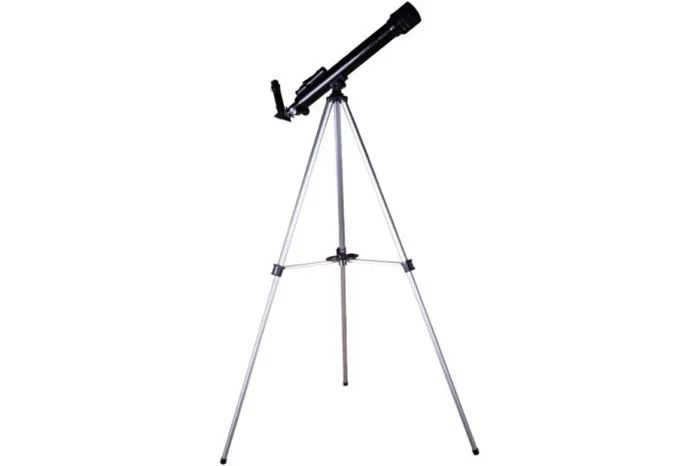
Konus Konuspace-4 50/600 AZ.
This versatile telescope serves as both a beginner-friendly device and a professional-grade instrument. With its superior optics, it offers a clear and detailed view of the moon as well as terrestrial objects. What sets it apart is the abundance of veneers and other accessories included, eliminating the need for any additional purchases.
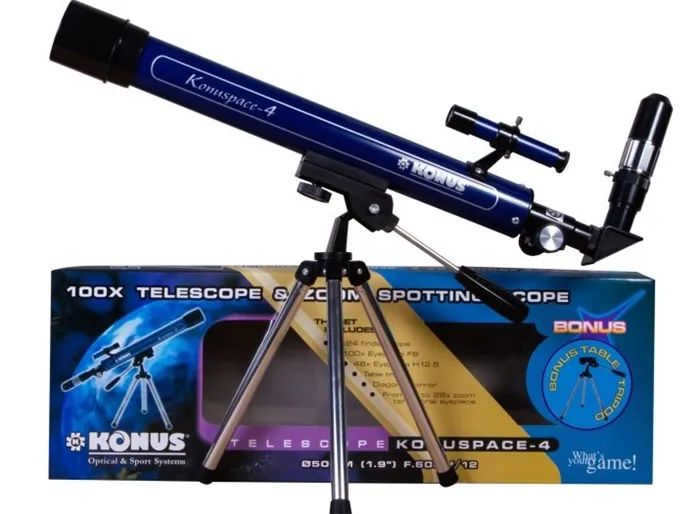
The utilization of this particular telescope provides an opportunity for novices to acquire knowledge in celestial navigation and gain a fundamental comprehension of the functionality of optical instruments.
The PolarStar II 700/80AZ variant is highly sought after.
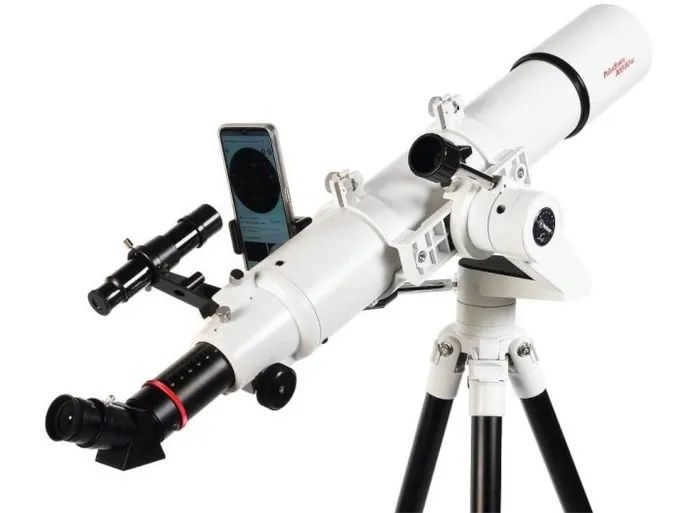
Today’s biggest telescopes in the world
The largest lenticular telescope ever built is the one constructed in Paris in 1900 for the World’s Fair. Its lens had a diameter of 1.25 meters and the tube itself was over 60 meters long. However, due to its massive size and weight, the telescope was installed horizontally and statically, making it impossible to conduct any observations. After 9 years, the telescope was dismantled.
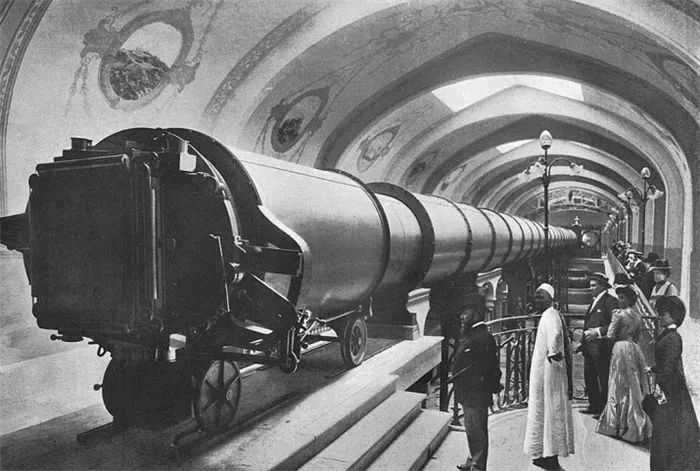
Chicago’s Yerkes Observatory houses the most massive contemporary telescope. With a lens measuring 1.1 meters, this instrument is capable of examining remote celestial bodies within our solar system. Constructed in 1897, the refractor coincided with the observatory’s inauguration.
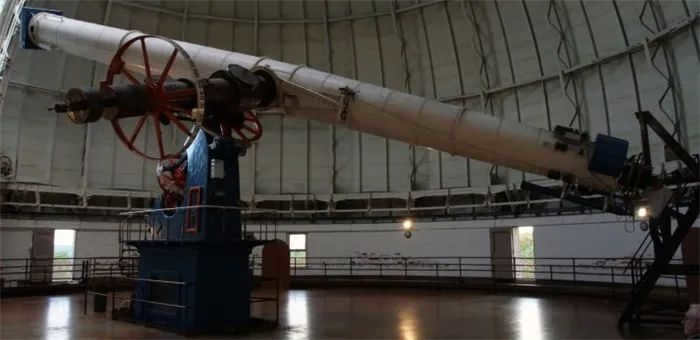
There are several notable refracting telescopes, such as the Astrophysikalisches Institut Potsdam, the Lyckee, Pulkovo, and Greenwich observatories, as well as the Nice, Archenhold, and Allegheny observatories. One particularly famous telescope is the James Clark Maxwell Telescope, which is situated in Hawaii, USA, at an impressive altitude of 4200 meters.
Therefore, the decision of whether or not to consider a refractor telescope for an astronomy enthusiast
is a matter of how to choose one.
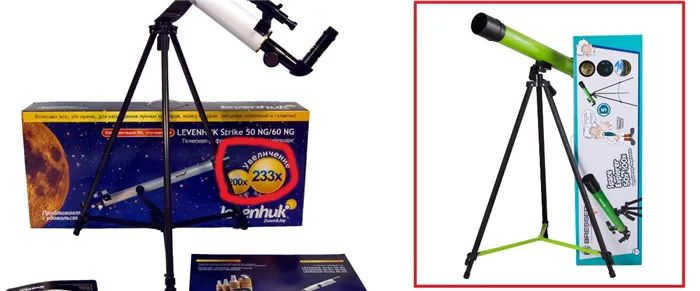
- Avoid, if possible, selecting models with plastic (acrylic) lenses in bright colorful packaging. These are typically children’s optical devices, and despite their often high price, they may only discourage interest in observing or result in wasted money. In most cases, these devices end up becoming just another toy in the room and are rarely used for their intended purpose. The price of such devices can range from 2,000 to 6,000 rubles. However, there are good models available in this price range, such as the Meade Infinity 50 mm with fully glass optics, which costs slightly over 4,000 rubles. Just exercise caution when making your selection.
- When selecting a telescope, prioritize a stable mount, as it is more crucial than the equipment itself. While eyepieces can be easily replaced if the telescope has a standard mounting diameter, the mount cannot be changed. The stability of the mount directly affects the amount of vibrations and shakes experienced during observations. In the case of weak and unstable mounts, even the slightest touch to the eyepiece, including by the eye, can cause the image to wobble.
Flashlight telescopes are an excellent option for young astronomers who are just starting out, particularly children. One of the major advantages of refractors is their closed tube design, which prevents dust and dirt from easily accumulating, unlike in Newtonian telescopes. Additionally, these telescopes have a quick thermal stabilization process, allowing users to set them up outside or on a balcony and begin observing in a short amount of time (although in winter, this may take a bit longer). On the other hand, telescopes with mirror lenses can take hours to thermostabilize. Another significant advantage of flashlight telescopes is their simplicity, ease of use, and high efficiency, especially for beginners and children. It’s also worth mentioning that these telescopes provide a direct, mirror-like image, and if equipped with a full or separate inversion prism, they can provide a completely direct classical image, just like a regular telescope.
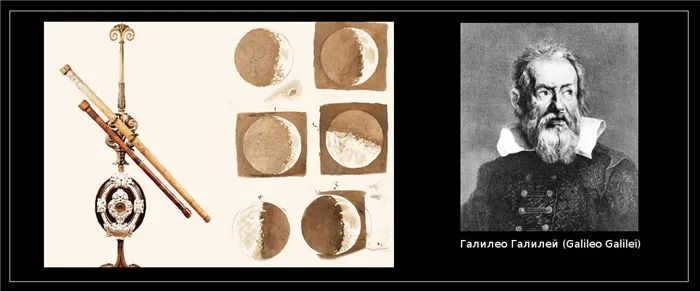
Indeed, the first telescopes were refractor telescopes, which utilized lenses. Galileo Galilei, a renowned astronomer, utilized improvised refractors with varying lens diameters, ranging from 37 mm to 58 mm. To enhance the quality of his images, Galileo had to significantly widen the aperture of these lenses, as they only had one lens with subpar aberrations during that era. However, these limitations did not hinder Galileo from making remarkable discoveries. In the present day, modern telescopes equipped with mass-market lenses boast significantly superior image quality, making any comparisons to those early telescopes quite challenging!
What do refractor telescopes look like?
Traditional refractor telescopes with two lenses
Other notable features include:
- As magnifications increase, these telescopes may still exhibit noticeable color distortion.
- The cost of a refractor remains relatively high.
- Consider carefully whether you truly need one for the price.
Here is an illustration: a 120mm refractor with a focal length of 600mm.


The photograph provides a clear depiction of the moon’s color, which is not present in the actual scene. This phenomenon is a result of chromatic aberration affecting the quality of the image.
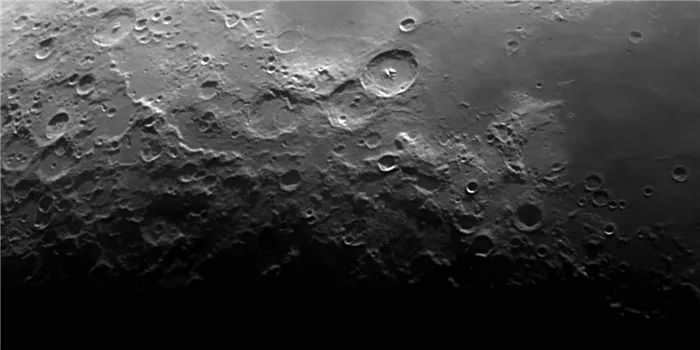
The moon appears distorted due to chromatic aberration. The photo was captured from a balcony in an urban location.


